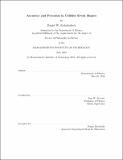Accuracy and precision in collider event shapes
Author(s)
Kolodrubetz, Daniel W. (Daniel Walter)
DownloadFull printable version (4.975Mb)
Other Contributors
Massachusetts Institute of Technology. Department of Physics.
Advisor
Iain W. Stewart.
Terms of use
Metadata
Show full item recordAbstract
In order to gain a deeper understanding of the Standard Model of particle physics and test its limitations, it is necessary to carry out accurate calculations to compare with experimental results. Event shapes provide a convenient way for compressing the extremely complicated data from each collider event into one number. Using eective theories and studying the appropriate limits, it is possible to probe the underlying physics to a high enough precision to extract interesting information from the experimental results. In the initial sections of this work, we use a particular event shape, C-parameter, in order to make a precise measurement of the strong coupling constant, s. First, we compute the e+e- C-parameter distribution using the Soft-Collinear Eective Theory (SCET) with a resummation to N³LL' accuracy of the most singular partonic terms. Our result holds for C in the peak, tail, and far-tail regions. We treat hadronization effects using a field theoretic nonperturbative soft function, with moments [omega]n, and perform a renormalon subtraction while simultaneously including hadron mass effects. We then present a global fit for [alpha]s(mZ), analyzing the available C-parameter data in the resummation region, including center-of-mass energies between Q = 35 and 207 GeV. We simultaneously also fit for the dominant hadronic parameter, [omega]1. The experimental data is compared to our theoretical prediction, which has a perturbative uncertainty for the cross section of ~/= 2:5% at Q = mZ in the relevant t region for [alpha]s(mZ) and [omega]1. We find [alpha]s(mZ) = 0:1123 +/- 0:0015 and [omega]1 = 0:421 +/- 0:063 GeV with X² / =dof = 0:988 for 404 bins of data. These results agree with the prediction of universality for [omega]₁ between thrust and C-parameter within 1-[sigma]. The latter parts of this study are dedicated to taking SCET beyond leading power in order to further increase the possible precision of calculations. On-shell helicity methods provide powerful tools for determining scattering amplitudes, which have a one-to-one correspondence with leading power helicity operators in SCET away from singular regions of phase space. We show that helicity based operators are also useful for enumerating power suppressed SCET operators, which encode subleading amplitude information about singular limits. In particular, we present a complete set of scalar helicity building blocks that are valid for constructing operators at any order in the SCET power expansion. We also describe an interesting angular momentum selection rule that restricts how these building blocks can be assembled.
Description
Thesis: Ph. D., Massachusetts Institute of Technology, Department of Physics, 2016. This electronic version was submitted by the student author. The certified thesis is available in the Institute Archives and Special Collections. Cataloged from student-submitted PDF version of thesis. Includes bibliographical references (pages 159-167).
Date issued
2016Department
Massachusetts Institute of Technology. Department of PhysicsPublisher
Massachusetts Institute of Technology
Keywords
Physics.